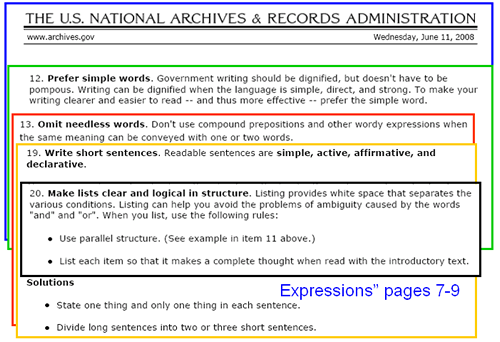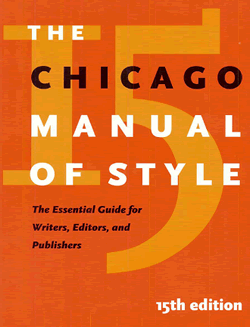Defining Plain Language Caltrans Style & Format
Greg EdwardsCalifornia Department of Transportation
"No one technique defines plain language. Rather, plain language is defined by results—it is easy to read, understand, and use."
http://www.plainlanguage.gov/index.cfmPlain Language Uniformity
| Ranking | State | Plain Language |
|---|---|---|
| 1 | California | no |
| 2 | Texas | yes |
| 3 | New York | no |
| 4 | Pennsylvania | yes |
| 5 | Florida | yes |
| 6 | Georgia | yes |
| 7 | Ohio | yes |
| 8 | Illinois | no |
| 9 | Michigan | yes |
| 10 | North Carolina | yes |
This presentation is a brief overview of:
|
|
|
Caltrans Specification Writing Style
- Foundation of plain language:
- Target reader
- Bidder before award
- Contractor after award
- Use active voice
- Speak directly to the reader
- Use appropriate tone
- Imperative mood: "You must do it" or "Do it"
- Target reader
- The Department is gradually changing the style and language of the specifications. The new style and language includes:
- 1. Use of:
- 1.1 Imperative mood
- 1.2 Introductory modifiers
- 1.3 Conditional clauses
- 2. Elimination of:
- 2.1 Language variations
- 2.2 Definitions for industry-standard terms
- 2.3 Redundant specifications
- 2.4 Needless cross-references
- The use of this new style does not change the meaning of a specification not yet using this style.
- The specifications are written to the Bidder before award and the Contractor after. Before award, interpret sentences written in the imperative mood as starting with "The Bidder must" and interpret "you" as "the Bidder" and "your" as "the Bidder's." After award, interpret sentences written in the imperative mood as starting with "The Contractor must" and interpret "you" as "the Contractor" and "your" as "the Contractor's."
- Unless an object or activity is specified to be less than the total, the quantity or amount is all of the object or activity.
- All items in a list apply unless the items are specified as choices.
- Interpret terms as defined in the Contract documents. A term not defined in the Contract documents has the meaning defined in Means Illustrated Construction Dictionary, Condensed Version, Second Edition.
For Example
PASSIVE voice:
The first segment shall be lined, completed, and accepted prior to initiating all subsequent pipe liner work. (17 words)
ACTIVE voice:
The Engineer must accept your installation of the first pipe liner segment before you start work on any other pipe liner segment. (22 words)
Caltrans Specification Writing Style (cont'd)
- Pillars of clear writing style:
- Use common terms and avoid jargon
- Use short sentences
- Use present tense
- Place words carefully (subject/object close to verb)
- Use "if, then" conditional statements
- Use lists
For Example
OLD STYLE & FORMAT:
When the final thickness of the cured-in-place pipe liner is less than the calculated minimum thickness provided in the submittals of this special provision, this liner may be brought into compliance at no additional cost to the State by removal and replacement of the undersized liner, addition of a second thin liner designed to support hydrostatic loads due to groundwater, or other repair alternatives as recommended by the Contractor and approved by the Engineer.
Same paragraph using active voice / conditional statement / list / imperative mood
NEW STYLE & FORMAT:
If the final thickness of the cured-in-place pipe liner is less than the calculated minimum thickness in your submittal, then you must do one of the following:
- Remove and replace the cured-in-place pipe liner.
- Add a second thin liner designed to support hydrostatic groundwater loads.
- Propose a method of repair and if the Engineer approves, repair the cured-in-place pipe liner.
ANOTHER EXAMPLE
THIS:
At the option of the Contractor, a growth regulator may be applied to mowed areas, provided the growth regulator is approved in advance by the Engineer and the growth regulator is applied in conformance with these special provisions. If a growth regulator is approved and applied, the growth regulator shall be at the Contractor's expense.
At the option of the Contractor, plants of a larger container size than those originally specified may be used for replacement plants during the first 125 working days of the plant establishment period. The use of plants of a larger container size than those originally specified for replacement plants shall be at the Contractor's expense.
TO THIS:
You may apply a growth regulator to a mowed area as specified in these special provisions if the Engineer approves.
You may use plants of a larger container size than those originally specified for replacement plants during the first 125 days of the plant establishment period.
Plain Language Mandates
- CA GOVERNMENT CODE Section 6219
- Government shall write in plain, straightforward language.
- June 1, 1998 Presidential Executive Order
- Requires agencies to write in plain language
- American Bar Assoc. 1999 Annual Meeting
- ABA urges agencies to use plain language
- Go California - Industry Capacity Expansion
- Uniformity of standards and specifications
CALIFORNIA GOVERNMENT CODE
6219. (a) Each department, commission, office, or other administrative agency of state government shall write each document that it produces in plain, straightforward language, avoiding technical terms as much as possible, and using a coherent and easily readable style. (b) As used in this section, a "state agency document" means any contract, form, license, announcement, regulation, manual, memorandum, or any other written communication that is necessary to carry out the agency's responsibilities under the law.
In his Executive Order, President Clinton directs federal departments and agencies to write in plain language including use of:
- "you" and other pronouns
- Common terms, everyday words, except for necessary technical terms
- Active voice
- Short sentences
THE WHITE HOUSE
WASHINGTON
MEMORANDUM FOR THE HEADS OF EXECUTIVE DEPARTMENTS AND AGENCIES
June 1, 1998
SUBJECT: Plain Language in Government Writing
The Vice President and I have made reinventing the Federal Government a top priority of my Administration. We are determined to make the Government more responsive, accessible, and understandable in its communications with the public.
The Federal Government's writing must be in plain language. By using plain language, we send a clear message about what the Government is doing, what it requires, and what services it offers. Plain language saves the Government and the private sector time, effort, and money.
Plain language requirements vary from one document to another, depending on the intended audience. Plain language documents have logical organization, easy-to-read design features, and use:
- common, everyday words, except for necessary technical terms:
- "you" and other pronouns:
- the active voice; and
- short sentences.
To ensure the use of plain language, I direct you to do the following:
- By October 1, 1998, use plain language in all new documents, other than regulations, that explain how to obtain a benefit or service or how to comply with a requirement you administer or enforce. For example, these documents may include letters, forms, notices, and instructions. By January 1, 2002, all such documents created prior to October 1, 1998 must also be in plain language.
- By January 1, 1999, use plain language in all proposed and final rulemakings published in the Federal Register, unless you proposed the rule before that date. You should consider rewriting existing regulations in plain language when you have the opportunity and resources to do so.
The National Partnership for Reinventing Government will issue guidance to help you comply with these directives and to explain more fully the elements of plain language. You should also use customer feedback and common sense to guide your plain language efforts.
I ask the independent agencies to comply with these directives.
This memorandum does not confer any right or benefit enforceable by law against the United States or its representatives. The Director of the Office of Management and Budget will publish this memorandum in the Federal Register.
Style Guide for the 2010 Specifications
STATE OF CALIFORNIA
DEPARTMENT OF TRANSPORTATION
DIVISION OF ENGINEERING SERVICES
OFFICE ENGINEER
May 2008
Standardization of Style, Format & Organization
- Caltrans 2010 Style Guide based on:
- Federal Register's writing guidelines,
- Chicago Manual of Style,
- Construction Specifications Institute (CSI), and
- AASHTO Guide Specifications for Highway Construction

www.archives.gov/federal-register/write/legal-docs/clear-writing.html
Chicago Manual of Style
 |
|
For example - word usage:
"who" or "whom" page 163, 5-56
"which" or "that" page 163, 5.60
"state" or "State" page 329 , 8.55 - also page 333, 8.65
"capital" or "Capitol" page 332 , 8.61
"effect" or "affect" page 198
"a" or "the" page 166 5.70 & 5.71
Construction Specifications Institute (CSI)
http://www.csinet.org/s_csi/index.asp
CSI Section Format
| CALTRANS
|
Specification Development
- Employ industry terms (Means Illustrated Construction Dictionary)
- Maximize uniformity with AASHTO and other states business practices (WDOSD)
- Provide complete "due diligence" documentation
- Reduce specification editing (use conditional clauses)
- Avoid customizing of specifications
Caltrans -- Status of:
- Conversion to Plain Language
- Organization of Specifications
Go to Appendix A of the 2010 Style Guide
Appendix A - Division Outline
|
|
100 General - 80% Complete
- 101 General
- 102 Bidding
- 103 Contract Award And Execution
- 104 Scope of Work
- 105 Control of Work
- 106 Control of Materials
- 107 Legal Relations & Responsibility to the Public
- 108 Prosecution and Progress
- 109 Payment
- 110 to 199 (BLANK)
Appendix A - Division Ouline
|
|
200 CONSTRUCTION--GENERAL
- 240 WATER POLLUTION CONTROL
- 240.1 GENERAL
- 240.1.1 Summary
- 240.1.2 Definitions
- 240.1.3 Submittals
- 240.1.3.1 General
- 240.1.3.2 Water Pollution Control Program
- 240.1.3.3 Storm Water Pollution Prevention Plan
- 240.2 MATERIALS
- 240.3 CONSTRUCTION
- 240.4 PAYMENT
Appendix A - Division Outline
|
|
1100 TRAFFIC CONTROL
|
|
In Summary, Caltrans Defines Plain Language as:
Easy to read, understand and use:
- STYLE
- Active voice, imperative mood
- Common terms, short sentences, lists
- Federal clear writing principles
- Chicago Manual of Style
- FORMAT
- Specification layout similar to CSI Section Format
- ORGANIZATION
- Similar to AASHTO Guide Specifications for Highway Construction & other states
CALTRANS OFFICE OF CONSTRUCTION CONTRACT STANDARDS
http://www.dot.ca.gov/hq/esc/oe/index.html#standards
Jill Sewell, Office Chief
Greg Edwards, Standards Engineer
(916) 227-6199
greg.edwards@dot.ca.gov
| << Previous | Contents | Next >> |

